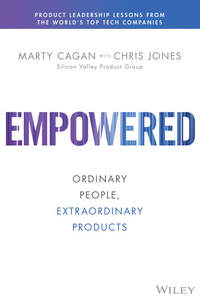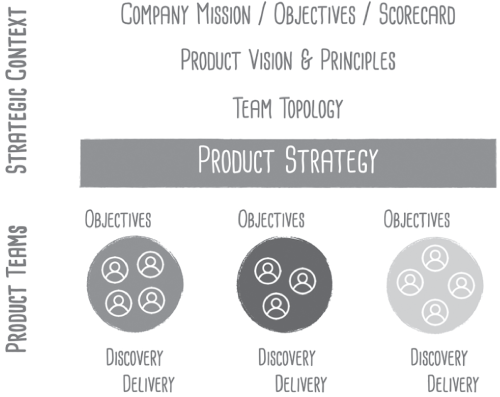
Recently I heard Marty Cagan speak as part of the McKinsey Product Academy Series. In the past Marty has spoken at my class and I have reviewed his book Inspired, my favorite book on product management.
Therefore I thought it was finally time for me to read the book he wrote with Chris Jones in 2021, Empowered. It can easily be used as a reference book when considering any one of a range of topics about how companies create extraordinary software products. However there are a few central themes which I thought would be helpful to describe here.
Two of the main messages around creating empowered product teams are:
- Give product teams problems to solve, rather than features to build. Empower them to solve those problems in the best way they see fit.
- Leadership is about recognizing that there's a greatness in everyone, and your job is to create an environment where that greatness can emerge. - Bill Campbell
Feature vs Empowered Teams (solve customer problems, achieve outcomes):
A central theme in the book is the distinction between feature product teams and empowered product teams. A feature team implements features and projects (output), and as such isn’t empowered or held accountable to results. In contrast, an empowered team is accountable for solving a customer problem or achieving a specific outcome, and is empowered to do so in the best way they see fit.
Difference Between Strongest Product Companies and the Rest
1. Role of Technology (it is the business, not an expense):
So many companies still have the old IT mindset when it comes to technology. It's viewed as a necessary cost rather than the core business enabler it needs to be. The people who work on the technology teams are literally there “to serve the business." In these scenarios, the product and technology teams are disconnected from the real customers—in fact, they're encouraged to think of their stakeholders as their customers. For strong product companies, technology is not an expense, it is the business.
2. Role of Product Leaders (coaching, strategy, managing to results, deep business and product knowledge):
Most product leaders are responsible for staffing the in-house feature factory, and keeping the trains running on time. The best product leaders are staffing and coaching product teams, creating product strategy, putting strategy into action, and managing to results
- You need to be very specific when identifying the most important business problems a product team should solve.
- Your role as a leader is in helping everyone on the team achieve the competence necessary to solve those problems.
- Data (how the product is actually used)
- Industry and domain knowledge
- Business and company knowledge
- Product operational knowledge (how the product actually works)
- (most importantly) Users & customer knowledge
3. The purpose of product teams (product managers, product designers, and engineers)
Consistent with the central theme of the book, Cagan believes that in strong product companies teams are given problems to solve, rather than features to build, and most importantly they are empowered to solve those problems in the best way they see fit and are then held accountable to the results.
Importance of Product Vision, Strategy, & Discovery
In empowered product teams:
- Product vision describes the future we are trying that improves the lives of our customers
- Product strategy helps us decide what problems to solve
- Product discovery helps us figure out the tactics that can actually solve the problems
Product vision keeps us focused on the customer and serves as a North Star
It provides the product organization with a common understanding of what we are hoping to accomplish together. A good product vision inspires ordinary people to create extraordinary products. A good product vision provides us with meaningful work.
When a company has grown to the point where there are multiple product teams—supporting many customers with their constant needs. It is very easy for each product team to get caught up in their own problems and their own work, losing sight of the overarching goal. The product vision represents the common goal and constantly reminds us of the larger purpose.
Product Strategy: Based on insights, it is how we make the product vision a reality while meeting the needs of the company as we go
While product strategy starts with focus, it then depends on insights. Insights come only after you spend hours studying your data, your customers, the enabling technologies, and your industry. Insights can come from anyone or anywhere – salesperson, new technology, random comment from a customer, or an academic paper. They might pertain to the dynamics of our business, our capabilities, new enabling technologies, the competitive landscape, how the market is evolving, or our customers. The foundation for significant insights is the strategic context found in the company objectives, the company scorecard/dashboard, and the product vision. Insights are both quantitative and qualitative insights; and they need to be shared and communicated.
Many companies have a stakeholder‐driven roadmap process, where they basically are trying to find a way to “fairly” divide up the engineering capacity across the different business stakeholders. But by not picking your battles and focusing on the few truly critical problems, most of the product team's work does not make an impact.
Product Discovery finds product market fit by considering value, usability, feasibility, viability (as discussed in Inspired)
- Value – will users buy and use it (Product Mgr)
- Usability – can they figure out how to use it (UX)
- Feasibility – can we build it (tech arch)
- Viability – part of our overall business
Discovery can’t be done by stakeholders, customers and prospects; they don’t know what is possible and they don’t know what solutions work
Often customers try to discuss solutions but they really are discussing problems. It is natural for a prospect to try to dictate requirements for features, but a product manager's job is to work to understand their underlying issues and constraints, and then work collaboratively with your prospective customers to determine if there's a general solution that will meet their needs. This form of collaboration is at the heart of the customer discovery program technique mentioned above and discussed in Inspired.
Collaborative Product Teams
Your company is probably accustomed to feature teams that exist very clearly to serve the business, and it can be difficult to replace them with empowered product teams that exist to serve our customers in ways that work for the business. Your product organization is moving from a subservient model to a collaborative model.
Part of this is done by product leaders establishing a direct relationship with the CEO (or general manager in a large company) and the other key executives (sales, marketing, service, finance, legal, business development.) The basis of this relationship is for the executives to believe that the product leaders have a deep understanding of the business and are committed to ensuring that the solutions provided will work for the various aspects of the business. This should be table stakes for the product leaders. Beyond that, there are three aspects the product leaders will be judged on: business results, product strategy, product teams
All of this may be Tougher in Larger Companies (Evangelism will help)
Personally, I think Marty’s suggestions seem to be better suited or maybe more straightforward to implement in small companies with more greenfield products. However, Marty does provide at least one key to being a strong (empowered) product leader in a medium-sized to large‐sized company, evangelism. Evangelism in this context means marketing to your own organization (e.g., product marketing, marketing, and sales). Some techniques used to help communicate the value of your product or what you’re proposing to your product teams, executives, key stakeholders, and investors include
- using prototypes
- sharing the customer pain
- explaining the product vision
- sharing your learnings
- giving great demos
- sharing the credit
- detailing the market opportunity
- showing your enthusiasm for your product
Check out more information from Marty Cagan at SVPG.


 RSS Feed
RSS Feed